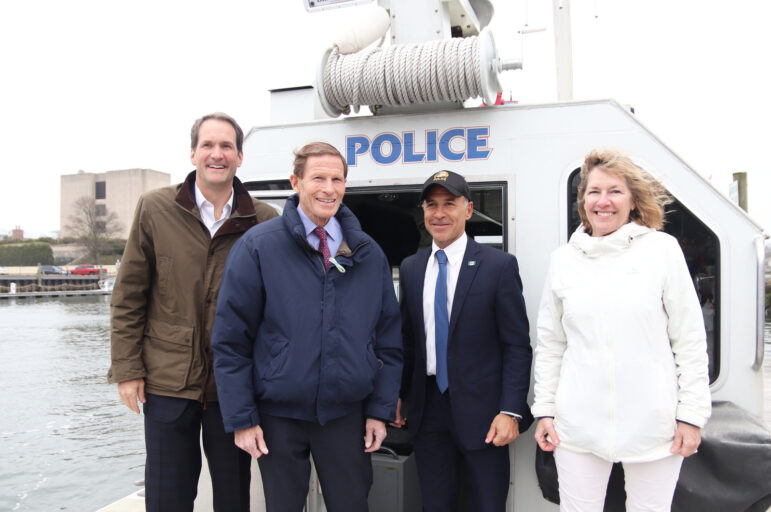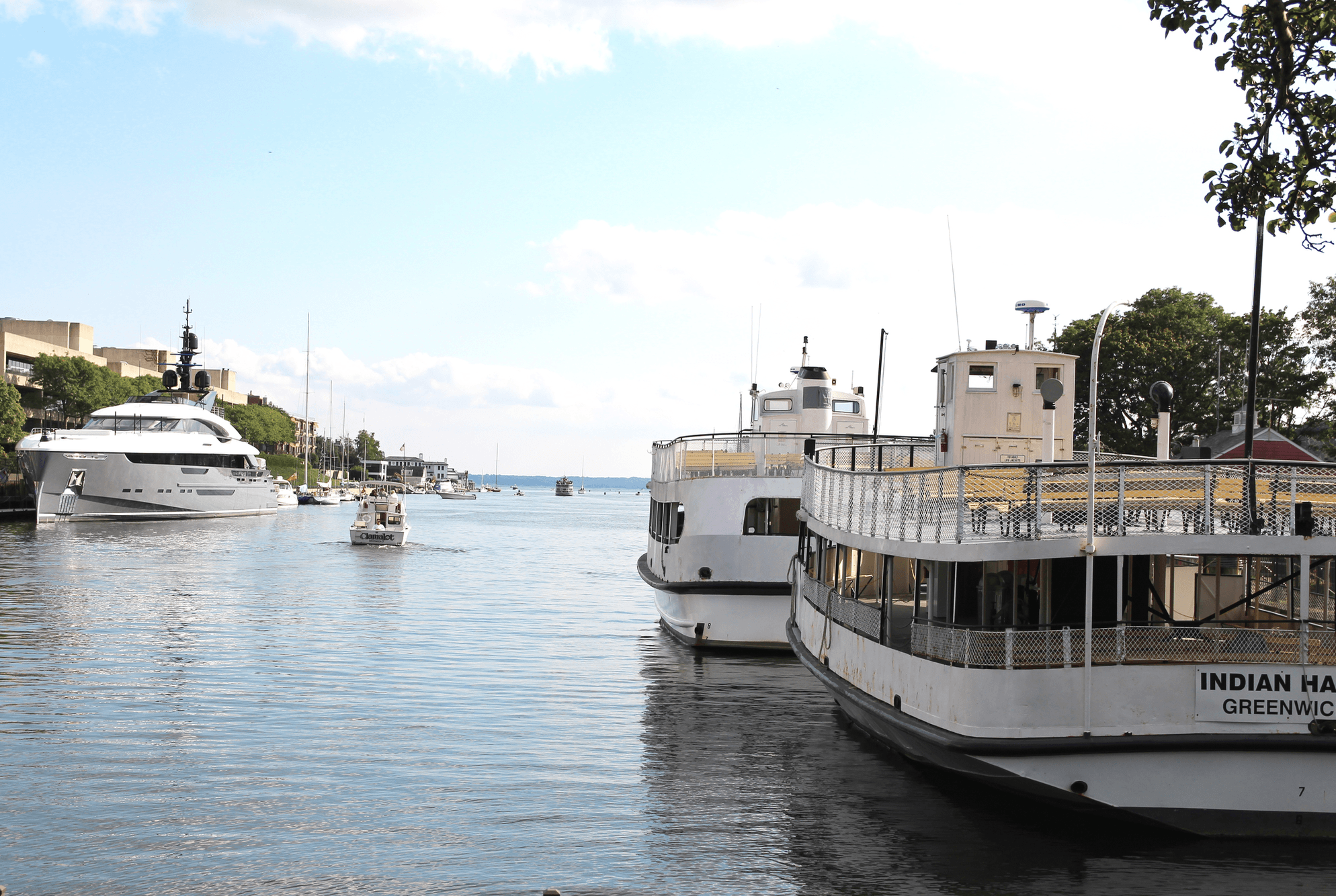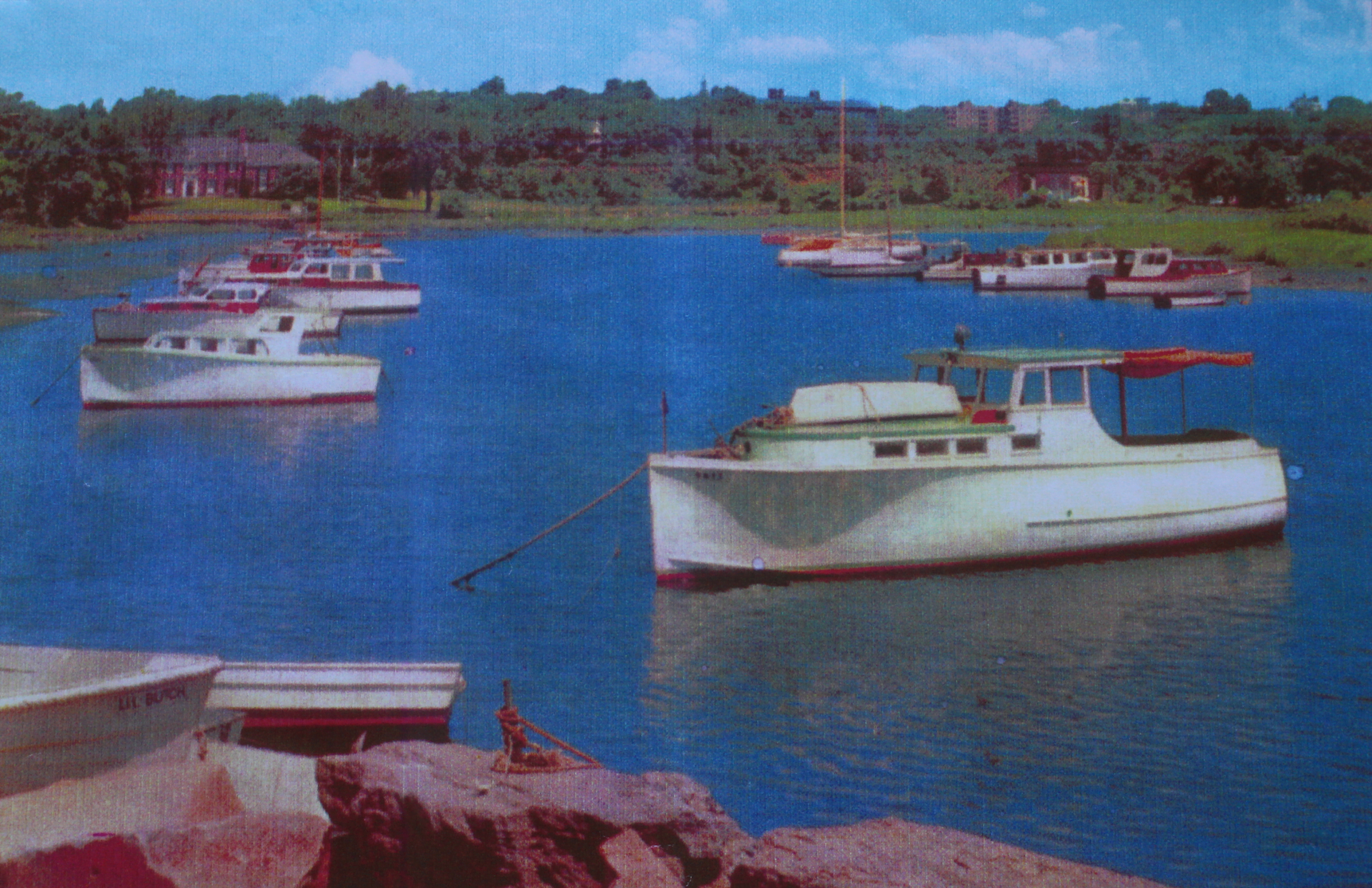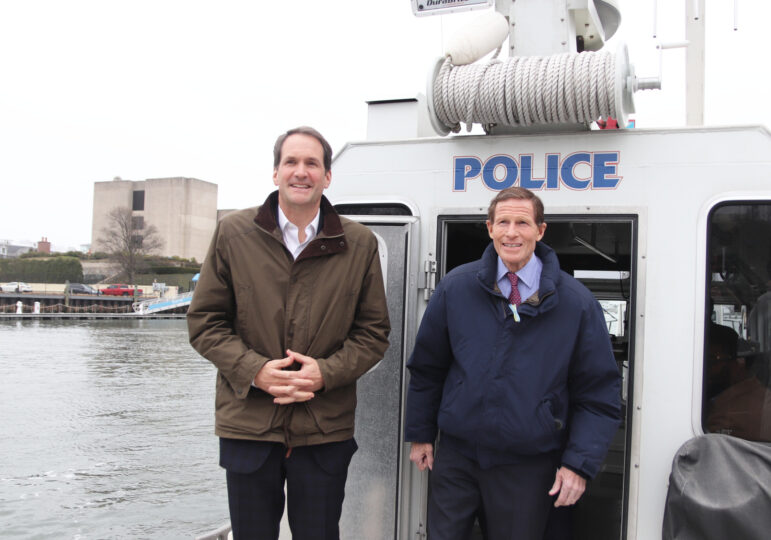Greenwich Harbor has been slowly silting in for decades, and dredging is long over due.
So it was an upbeat moment on Wednesday when federal and local officials gathered at the Greenwich Police Marine Operations dock to mark the approval of a $500,000 federal grant in fiscal year 2023 to kick-start the process.
Specifically, the funding was secured from the Army Corps of Engineers who will oversee the project. They will test dredge material to determine whether it is contaminated and how it might be safely disposed.
More than just the Marine Police vessels rely on accessing the federal navigation channel in the harbor.
Town ferry boats – The Island Beach, the Indian Harbor and the smaller Islander II – as well as the Harbor Master Boat are all present along the channel.
On the other side of the channel, large yachts are often docked at the Delamar Hotel.



The federal navigation channel that runs from the ferries out to the harbor is specified to be 13 ft in depth, but in some places it’s as shallow as 7 feet at low tide. Recreation vessels with a six foot keel can’t access the harbor. There have been moments that larger vessels have arrived at high tide and gotten stuck when the tide goes out.
Around the corner, in the area of Grass Island, which is not part of the federal navigation channel, there are slips that are no longer usable because the water is so shallow.
Wednesday’s press conference was organized Congressman Jim Himes, Senator Richard Blumenthal and Greenwich First Selectman Fred Camillo, who said he was grateful to the federal delegation.
“This is a happy occasion,” Camillo said.
“Greenwich has been blessed with a shoreline and islands and the residents cherish the water. But like other bodies up and down the coastline we’re starting to lose a lot of water with the silting and the need for dredging all over the place becoming a real issue.”
“This federal grant in fiscal year 2023 for $500,000 – it gets us started,” he added.
A key theme was that dredging will be a partnership.
“Greenwich has skin in the game,” Senator Blumenthal said.
The town of Greenwich has set aside $2 million for dredging, but the federal government is anticipated to cover most of the costs, which have been estimated at upwards of $8 million.

Himes explained that dredging in Greenwich would be a federal, state and municipal joint venture.
“It’s exactly like the Byram River flooding. It requires permitting and input from the Army Corps of Engineers, resources from the town and advocacy of the Senators and me to make sure the federal funds are there and that the federal government moves with alacrity so that this can get done quickly,” Himes continued. “We’re here partly to celebrate the initial down payment, but also to commit to each other to get this done through partnership at the federal and municipal level.”
Senator Blumenthal, who like Congressman Himes lives in Greenwich, also noted that at low tide parts of the inner harbor have also become so shallow that they are effectively closed to navigation.
“Navigation is a key word because that’s what invokes federal jurisdiction,” Blumenthal said.
“Dredging our harbors is something the State of Connecticut has ignored for too long,” he added. “If you go up and down the coastline of Connecticut, there are harbors similarly disadvantaged because of the accumulation of sediment – especially as you near the Rhode Island border. For example, New London and New Haven, both centers of potential commerce – jobs and economic activity – which could be unlocked by dredging.”
Blumenthal said the Greenwich Harbor dredge project could serve as an example to other coastal communities.
“Greenwich can get it right – test the sediment, then remove it, deposit it safely for the environment, for recreation, and all the interests at stake.”
As for testing, he added, “Whatever the site is, first do no harm. Testing the sediment and dealing with any problems that may arrive. It’s key to unlocking millions more. This kind of project is exactly what the Army Corps of Engineers should be doing. It’s within its jurisdiction and obligation.”
Congressman Himes explained that part of the funding would go toward architecture and designing of an underwater cell to retain silt.
Blumenthal noted that in Groton, which is home to General Dynamics Electric Boat, the harbor must be dredged to get the submarines out, and that had been the subject of ongoing controversy over the years.
“As a matter of national security,” he said. “You can’t make submarines in Groton if you can’t get them out to sea.”
“We now have technology to cap it at sea,” Blumenthal said.
Himes said the nature of the sediment would determine whether it could be marine deposited, which is inexpensive, or deposited upland, which would be “a cost disaster” requiring all the sediment to be trucked away.
The Connecticut Dept of Energy and Environmental Protection (DEEP) has the ultimate authority to determine where the sediment can go.
Congressman Himes noted that nearby, the Mianus River, also a federal channel, was dredged four years ago, and, fortunately that sediment did qualify for marine disposal.

Blumenthal said one challenge had been that New York had sued to stop Connecticut’s dredging projects.
Why?
“Long Island doesn’t silt,” Himes said.
Senator Blumethal explained that the currents in New York’s waters move the flow of sediment out to the ocean.
“They have the great luxury of not having the issue, so they have been particularly aggressive in trying to stop anyone from depositing anything, anywhere,” he said.
The officials said the testing would likely get underway this summer.
Afterward the press conference, elected officials and reporters looped around the harbor in a Greenwich Marine Division vessel to observe the dredging needs up close.
On Thursday, Janet Stone McGuigan, who is the Greenwich Selectperson and Board of Selectmen liaison to the Harbor Management Commission thanked Congressman Himes for the critical advocacy his office has given to Greenwich Harbor dredging.
“The Greenwich Harbor Management Commission, and particularly its chair, Bernie Armstrong, equally deserve much credit for tenaciously keeping this item at the top of its priorities,” she said. “The Federal channel in Greenwich Harbor has not been dredged in over 50 years, and there are places where larger boats cannot navigate at low tide.”
“Greenwich Harbor is a Town resource that we need to maintain,” she added. “The Army Corps of Engineers has many projects it needs to fund with limited resources. Testing the dredge site is only a first step, but I’m confident that with support from our Congressional representatives it will get done.”

